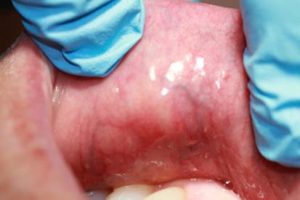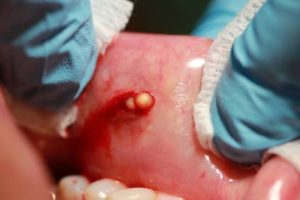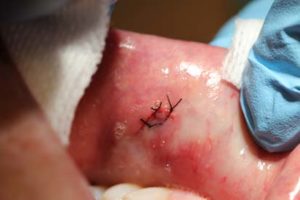By Michael Koceja, DDS

Figure 1: Patient presents with long standing lump in lower lip that tends to enlarge and decrease in size (Differential diagnosis, mucocele)
Technology continues to provide us with the new tools needed to improve patient care. Things we dreamed of 25 years ago are now part of our daily practice. Digital radiography, CAD/CAM, lasers, and other advances in technology have changed dentistry, but advances in technology come with a certain cost.
- Technology can be expensive.
- Technology can put us on auto-pilot – we still need to know how to “land the plane.”
- We can be overcome with too much technology. What is enough technology? When is it too much technology?
These questions need to be answered every time we incorporate new technology into our practices, but sometimes we need to get back to basics. Although materials and techniques have changed since graduating from dental school 25 years ago (Remember hydrochloride, gold foils, and the concept of implants from a guy named Branemark?), basic concepts have remained constant.
Technology is not a magic wand, but one technology that can provide better results in numerous procedures is a soft tissue laser. Each company touts its wavelength to be the best and tries to convince you its laser does so much more than the rest. So how do you choose? Go back to basics and think of a soft tissue laser as a tool to help with:
- Tissue contouring and retraction prior to impressions
- Access to facial or subgingival decay
- Treatment and excision of soft tissue lesions
These are just a few of the most common uses of a soft tissue laser, but there are
others.

Figure 2: Excision of mucocele with Precise 810nm Diode Laser, note minimal bleeding
Doctors want a user-friendly, reliable, cost-effective soft tissue laser. One laser that fits this category is the CAO Precise Diode laser. This 810nm diode laser is easy to set up, easy to use, very reliable and also cost effective. The CAO Group located in Salt Lake City, Utah, has been making lasers for over 10 years, so they are not new to the party like a lot of other laser companies that have sprung up. Customer service is excellent. If there is a problem with your laser, they ship out another so there’s no down time waiting for repairs, unlike the policies of other companies.
The Precise also has a few user-friendly and unique features that make it easier to incorporate into your daily routine: a retractable fiber (this keeps the fiber protected and unneeded extra fiber out of your way), a magnetic handpiece holder (this keeps the handpiece easily accessible), and a wireless foot pedal. The Precise also has a very cost effective cleavable fiber system that keeps your per-use cost to about $1.00, with no expensive tips to purchase. Other lasers may cost less, but the tips may cost up to $12 per use.

Figure 3: Sutures placed (6-0 silk) following removal of mucocele, (conservative incision and closing of wound)
In addition, some lasers have too much technology, with up to 30 presets and unlimited pulse settings. The Precise has a continuous and pulsed mode and four presets, just the right amount for most dentists.
The benefit of utilizing new technology is ease of use. How many times have we gone into our offices on the weekend to treat an emergency patient without our assistant, only to find we don’t know how to operate equipment, and we can’t find what we need to complete the procedure. A laser should not complicate your treatment; it should make it easier. Training provided with your laser should also be “down-to-earth” on real procedures with easy-to-follow setup and use. The Precise laser training follows this concept.
A great clinical example of utilizing a diode laser is a mucocele removal of the lower lip (Figures 1-3). In this case the patient was seeking an alternative to a scalpel. The laser made a clean incision with minimal bleeding. The mucocele was removed and a few small sutures (6-0, silk) were placed. Healing was uneventful, with only limited over-the-counter analgesics. Maybe that’s why the AAP (American Academy of Periodontology) states lasers can be less invasive, cause less bleeding, and provide better, faster, healing than traditional scalpel methods.
So remember, when thinking of purchasing a laser for your practice, incorporate the technology that helps provide the best care. It doesn’t have to have the most bells and whistles or cost the most. It just has to be easy to use, reliable, and provide another “basic” tool that can be utilized every day.
